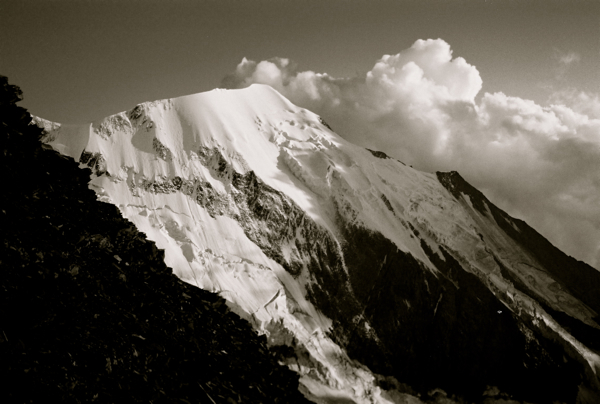
Mont Blanc, at 4,810 meters (15,781 feet), is the tallest mountain in Western Europe and taller than any mountain in the contiguous USA. On September 1, 2009, I solo climbed Mont Blanc with trail runners (with crampons and an ice ax) in 48 hours.
Solo climbing Mont Blanc is dangerous; attempting it in sneakers adds to the risk. I don't recommend doing it, but I will explain why and how I did it.
About the photos: I lost my camera before my climb so I had to use a disposable camera. It took lousy photos, so I tried making them more interesting by altering their colors.
Some facts to put the climb in perspective:
- Yosemite's Half Dome hike has 1,600 meters (4,800 feet) of elevation gain; the summit is 2,650 meters (8,842 feet).
- Starting from Chamonix, a Mont Blanc climber enjoys 3,800 meters (12,500 feet), or about 2.5 times more elevation gain than Half Dome.
- Mt. Rainier is at about the same latitude but is 1,400 feet shorter than Mont Blanc (4,492 vs. 4,810 meters). Because there is only half the oxygen you get at sea level, this extra bit of climbing can be challenging.
I had Acute Mountain Symptoms (AMS) the whole way up. I felt like a zombie most of the time.
Mont Blanc is located in Chamonix, France. You can approach it up the Italian side, but I am half French, so I picked the French side. Most people take either a gondola or cog train to save them up to 2,000 meters of climbing. However, I avoided the lift and started climbing from Chamonix (technically, I started from Les Houches) at 6 p.m. My starting altitude was about 1,000 meters (3,300 feet).
Agrandir le plan
By sunset the trail ended at a stop on the cog train tracks. Three friendly Italians had set up camp inside an abandoned building there. I crawled in through the window and joined them. I fell asleep around 9:30 p.m.
Although I had all the stuff I needed to stay two nights on the mountain, I had this crazy idea of getting as high as possible in one day. So I woke up at 1 a.m., stepped over the sleeping Italians, and started following the train tracks up the mountain under the starlight.
By 2 a.m. I reached the end of the train tracks and started following the trail up the mountain. I was feeling weak and a little dizzy. I couldn't believe it. I was only at 6,000 feet! What was wrong with me?
I ignored the symptoms, but by 3 a.m. I gave up. I didn't care if I was only 2,000 meters. My body was protesting and I had to listen to it given that another 2,800 meters climbing remained. I was so weak that I just pulled out my pad, set it on a not-so-flat rock, collapsed on the stone, and crawled into my sleeping bag.

I slept for about three hours. Dew covered my sleeping bag, but it was warm enough. I felt a bit better but still had a headache. I was packing my wet sleeping bag when the Italians walked by. Their positive spirit encouraged me to continue up with them to the nearby Baraque Forestale Des Rognes hut. Less than 30 minutes later, we got to this unmanned hut. They rested for about 20 minutes and Francesco Ava (on the far right) took the photo above.
I tried to eat something. I had zero appetite: classic AMS. I shoved an energy bar in my mouth and almost threw it up.
Although they would continue to the Gouter shelter, I stayed behind to sleep. I was still feeling frail and nauseous. I lay watching the spinning ceiling for several hours while energetic and enthusiastic hikers came and went from the hut.
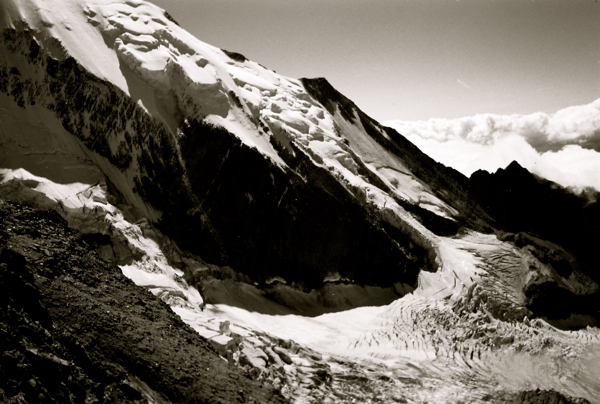
Aiguille de Bionnassay, just over 4,000 meters. Crevasses litter the bottom of the glacier.
Finally, around 3 p.m., I felt good enough to eat food and drink. Fueled up, I hiked up to a manned shelter: La Tête Rouse. Although I was feeling better, I rested at the shelter for a couple of hours to gather more strength for the upcoming climb (see photo below).

I am pointing to Le Grand Couloir on Mont Blanc by La Tête Rouse. You have to climb this while listening to rocks fall nearby. If you are unlucky, a rock will fall on your head. Just hope your helmet protects you just enough to live with only a little brain damage.
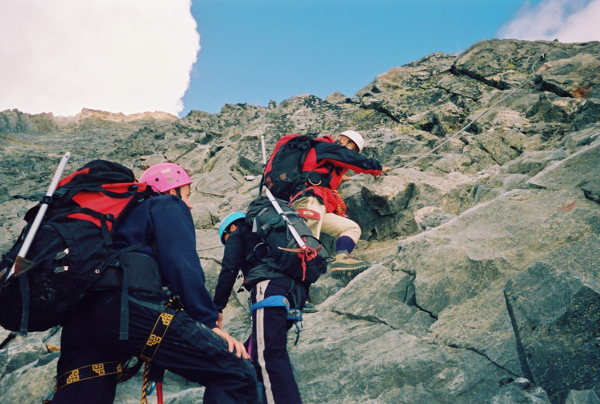
This is up Le Grand Couloir. Notice all the gear people were carrying. Many had plastic mountaineering boots. I got some strange French looks with my tiny backpack and trail runners.
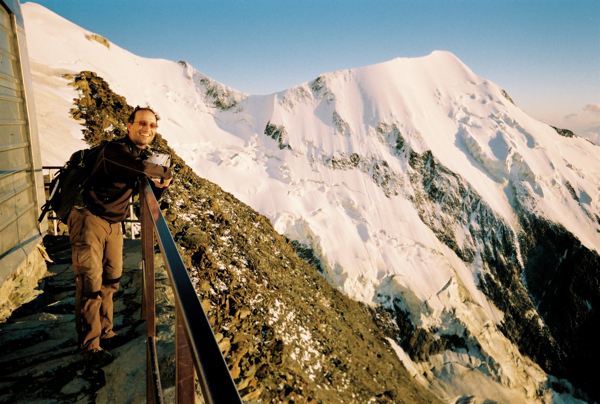
At the Gouter Hut Shelter (3,800 meters / 12,500 feet). Nice view of Aiguille de Bionnassay, a part of the Mont Blanc Massif.
I arrived at the Gouter Hut Shelter at 8 p.m. I paid 22 euros ($30) to have a bunk for a few hours. I woke up at 1 a.m. to start climbing. I stumbled to the kitchen and sat on a bench staring out into space. Energetic mountaineers were gearing up all around me while I spent 5 minutes trying to find the energy to get a water bottle out of my backpack.
Although my brain was mush, it was rational enough to know that if I can barely find the strength to drink water, there is no way I will climb 1,000 meters into thin air.
I crawled back into bed and set my alarm for 5 a.m., hoping that 4 more hours of rest will help me acclimatize. Miraculously, it did. Although I still felt weak at 5 a.m., I had the strength to get my water bottle (a good sign). Nearly everyone had already left the shelter hours before, so I was one of the last to leave. It is not good to leave so late, because as the day progresses storms come, snow bridges weaken, and rocks fall more often.
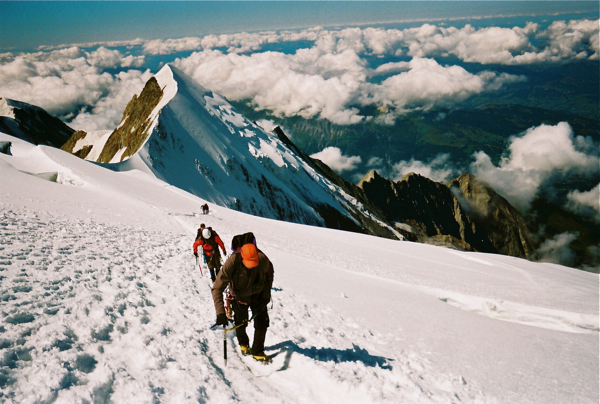
I started hiking up at 5:30 a.m. I was walking here in the darkness of the morning with a headlamp. It was beautiful and eerie in the starlight. (I took this shot on the descent.)
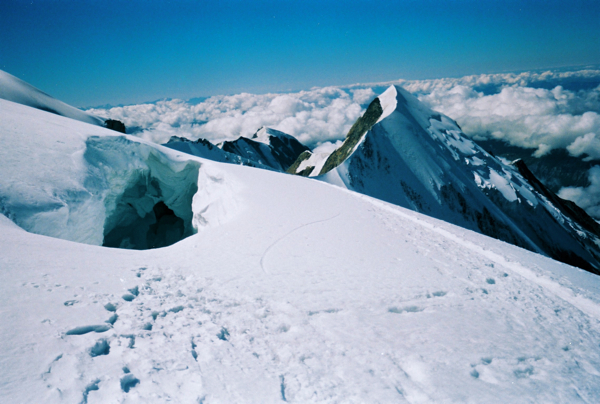
I was not roped into anyone, so I didn't get to close to this gaping crevasse. I caught up to a group of 5 and followed their tracks and headlamps up the mountain.
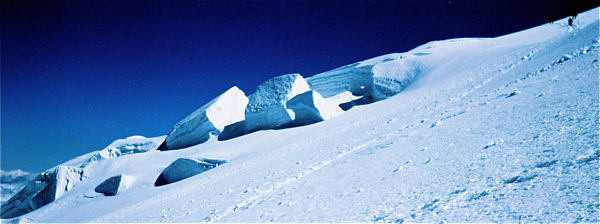
Blocks of ice. The people in the upper right-hand corner give you a sense of scale. I passed this as the sun rose.
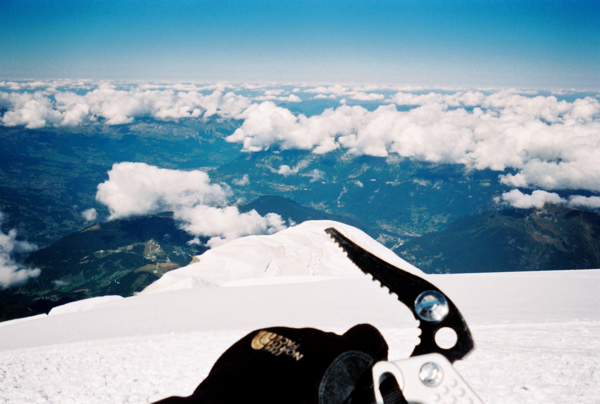
The tip of my ice ax points to the highest manned hut, which is around 12,500 feet or 3,800 meters.

Ice crumbling down the glacier.
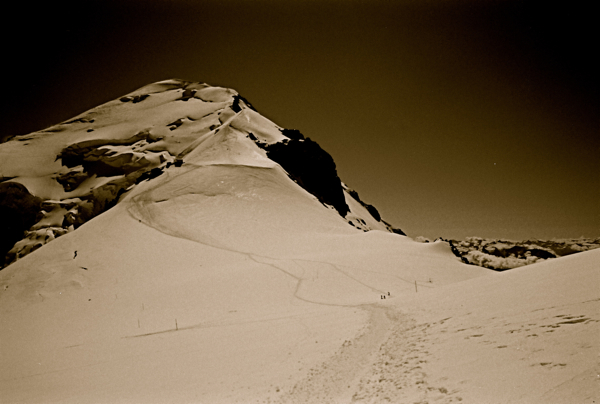
Icy way to top.
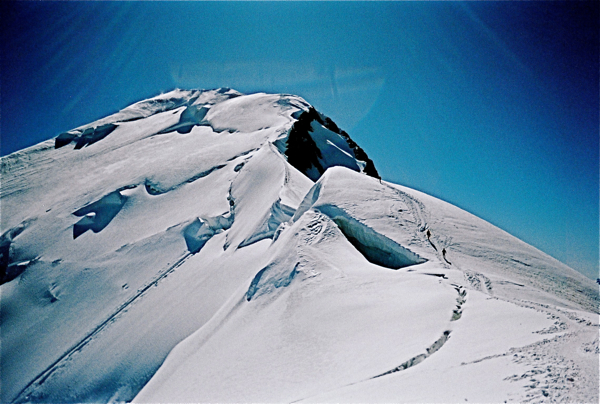
Footsteps to the top of Mont Blanc. You can see the path to the top. It stays on the right side, on the snow. Some parts are steep with sharp drop-offs on either side.

Delirious with nausea, I nearly quit here. When I saw this steep 300 meter (1,000 foot) climb, which started at 14,500 feet, my body told me to turn around and descend. My mind pressed the OVERRIDE button.
I reminded myself that on my second trip up Mt. Rainier I vomited twice due to the altitude. Although I had the urge to vomit several times this time on Mont Blanc, I still hadn't done it, so I wasn't completely spent. I still had some reserve left in me. I stopped sitting on the snow feeling sorry for myself and put one foot in front of the other.

Mont Blanc is a cold and windy place. My oxygen-starved body took one step every 3 seconds up this steep slope.

Nearby big mountains look small.
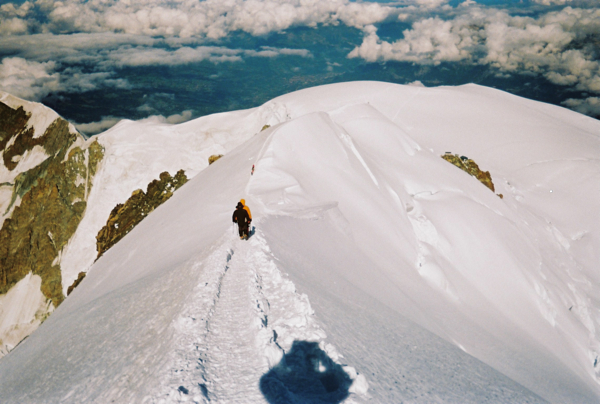
Be prepared to self-arrest with your ice ax if a gust of wind tosses you over either edge.
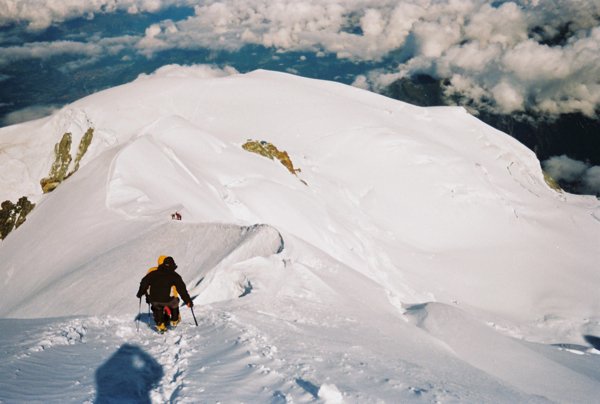
It is steeper than it looks.
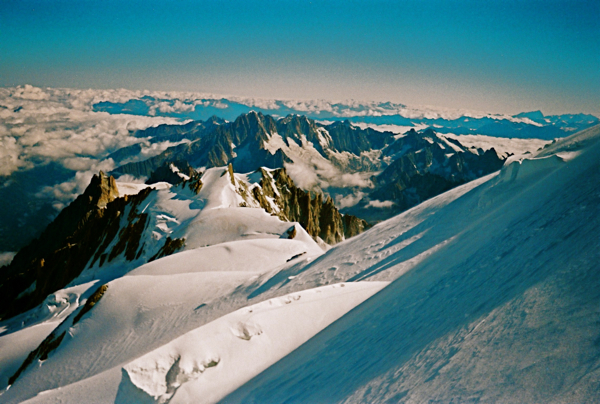
View from Mont Blanc is breathtaking... literally!
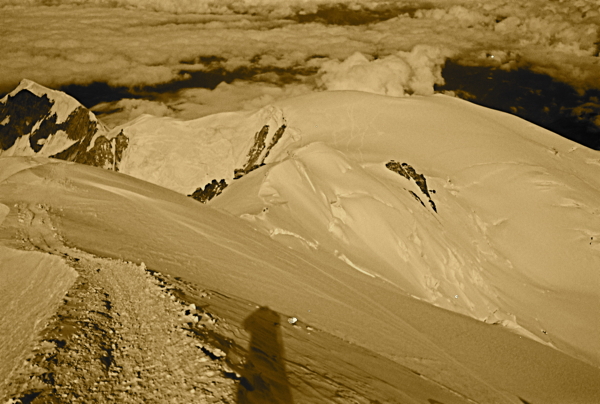
Mt. Blanc view through sunglasses.

You can see an emergency shelter about halfway up this climb. It holds 12. The Bivouac Vallot, at 4,352 meters, is the highest hut in Western Europe. It is higher than the summit of Mt. Rainier.
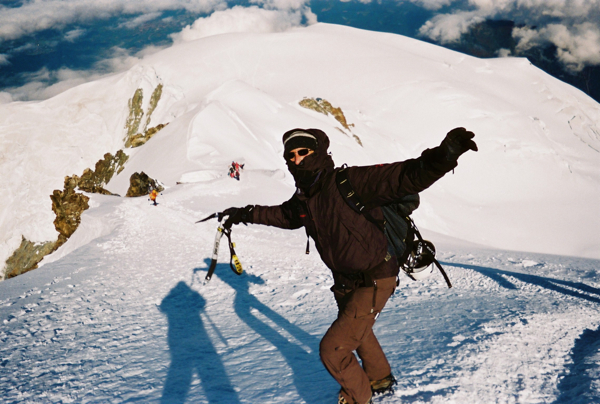
I was breathing hard, incapable of speech, and my hands were freezing. However, I still had some sense of humor, imagining that I was snowboarding down the mountain.

Snow looks soft like whipped cream, but it wasn't.
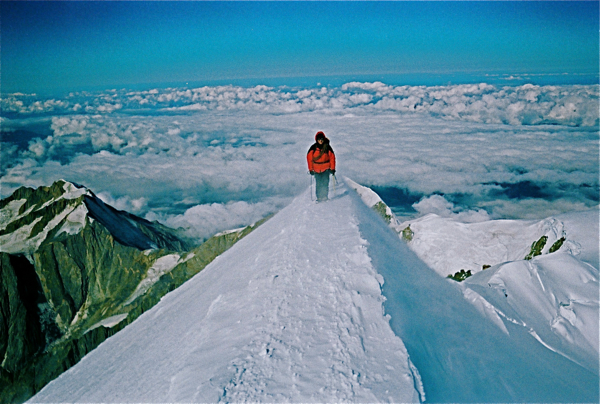
Some guy behind me, about 3 minutes from the summit. Even though it is an easy slope here, each step takes a big effort.
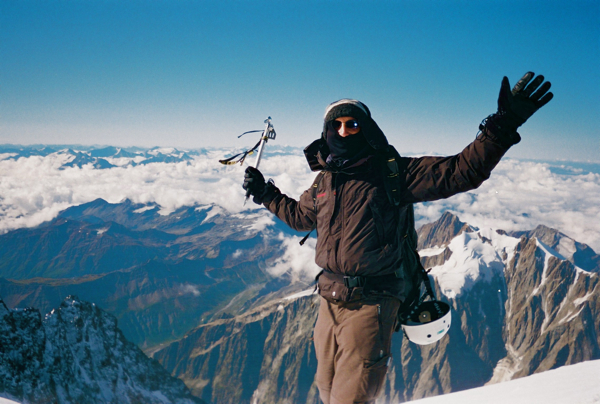
Looking like a suicide bomber who was about to die due to lack of oxygen and not an explosion. I didn't have super warm clothes and my hands were quite cold, so I didn't stay long at the top. It was 10:30. It had taken five hours to get here from the Gouter Hut.

The wind was whipping at 4,810 meters on the summit of Mt. Blanc. All of Western Europe was below me, but I didn't feel like a king. Instead, I felt small and frail.

On the summit of Mont Blanc 4,810 meters (15,781 feet). Notice the crampons on my trail runners. The biting wind sapped my strength, so after the victory shots, I quickly descended 3,810 meters back to the land of oxygen.
On the way down, I caught up to the 20-something Italians. One of them (Francesco Ava) quit at 4,000 meters after vomiting. He managed to shoot 11 pretty shots of Mont Blanc before throwing up. His partner, Fabrizo, took several awesome shots that day that shows what all us lucky climbers saw that day. The other two made it but were so exhausted that they spent nearly as much time going down as going up.
Why I did it alone: Because I couldn't find a partner and I didn't want to pay for a guide. I have navigated up and down Mt. Rainier in whiteout conditions. Although crevasse risk is there it hadn't snowed in a while so the crevasses and footprints were visible, making the solo climb less risky.
Why I did it in trail runners: I have been traveling in Europe for a year and I didn't have boots. The crampons held tight most of the time and only needed adjustment a few times. I have mutant feet that are usually always on fire. I walked 1,000 km of snow on the CDT in trail runners, so I know that my feet can handle cold temperatures with little protection. Renting boots costs money and adds the risks of getting blisters on untested boots. My shoes were one year old but had taken me up several snowy Eastern European mountains, so I was confident they could take me up Mont Blanc.
What I learned: Listen to your body and let it acclimatize. It surprised me how an extra 4 hours of rest in the Gouter Shelter made such a huge difference. I went from barely being able to picking up a water bottle to climbing to the roof of Western Europe!































